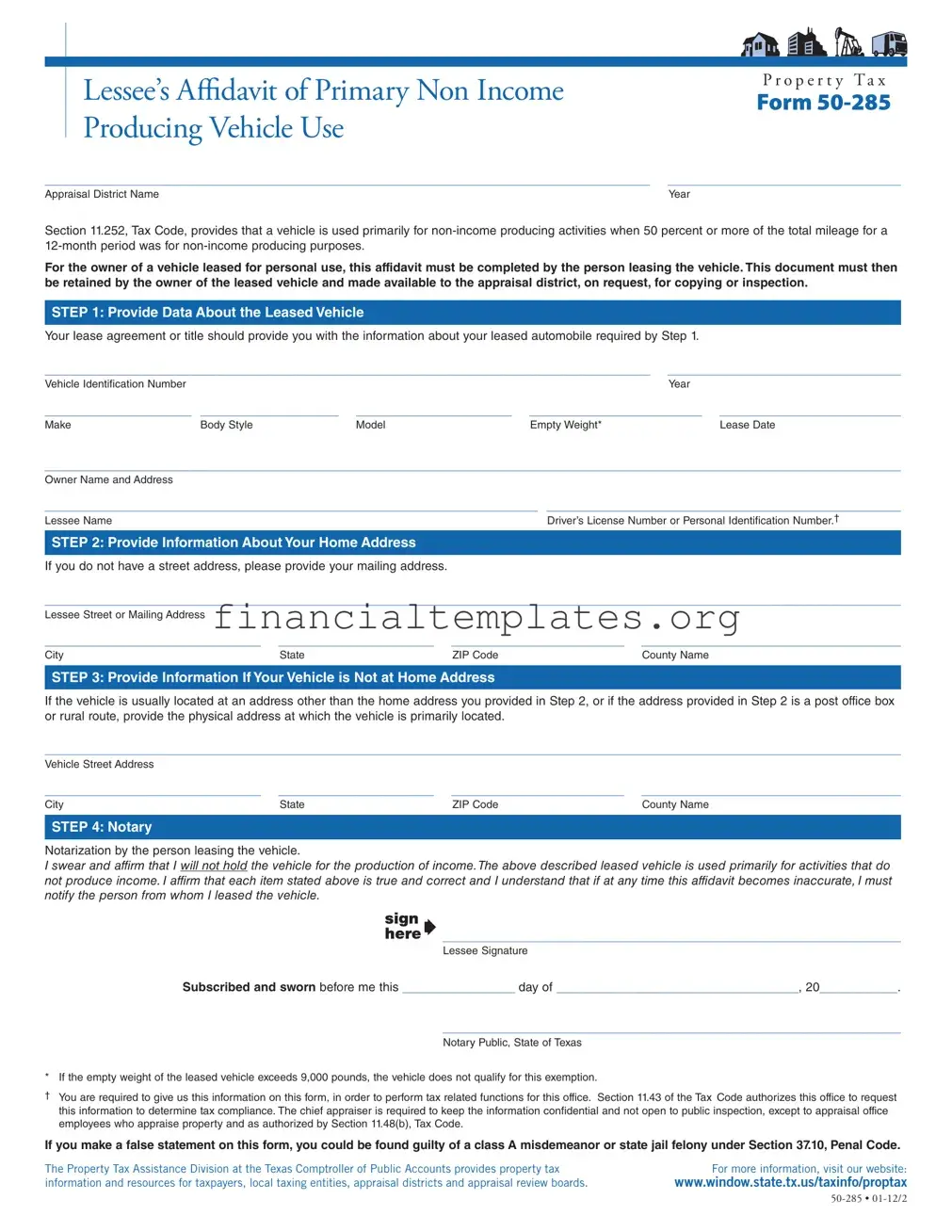______________________________________________________________________ |
___________________________ |
Appraisal District Name |
Year |
Section 11.252, Tax Code, provides that a vehicle is used primarily for non-income producing activities when 50 percent or more of the total mileage for a 12-month period was for non-income producing purposes.
For the owner of a vehicle leased for personal use, this affidavit must be completed by the person leasing the vehicle. This document must then be retained by the owner of the leased vehicle and made available to the appraisal district, on request, for copying or inspection.
STEP 1: Provide Data About the Leased Vehicle
Your lease agreement or title should provide you with the information about your leased automobile required by Step 1.
______________________________________________________________________ ___________________________
Vehicle Identiication NumberYear
_________________ ________________ |
__________________ |
____________________ |
_____________________ |
Make |
Body Style |
Model |
Empty Weight* |
Lease Date |
___________________________________________________________________________________________________
Owner Name and Address
_________________________________________________________ _________________________________________
Lessee Name |
Driver’s License Number or Personal Identiication Number.† |
STEP 2: Provide Information About Your Home Address
If you do not have a street address, please provide your mailing address.
___________________________________________________________________________________________________
Lessee Street or Mailing Address
_________________________ |
__________________ |
____________________ |
______________________________ |
City |
State |
ZIP Code |
County Name |
STEP 3: Provide Information If Your Vehicle is Not at Home Address
If the vehicle is usually located at an address other than the home address you provided in Step 2, or if the address provided in Step 2 is a post office box or rural route, provide the physical address at which the vehicle is primarily located.
___________________________________________________________________________________________________
Vehicle Street Address
_________________________ |
__________________ |
____________________ |
______________________________ |
City |
State |
ZIP Code |
County Name |
STEP 4: Notary
Notarization by the person leasing the vehicle.
I swear and affirm that I will not hold the vehicle for the production of income.The above described leased vehicle is used primarily for activities that do not produce income. I affirm that each item stated above is true and correct and I understand that if at any time this affidavit becomes inaccurate, I must notify the person from whom I leased the vehicle.



 _____________________________________________________
_____________________________________________________
Lessee Signature
Subscribed and sworn before me this _____________ day of ____________________________, 20_________.
_____________________________________________________
Notary Public, State of Texas
* If the empty weight of the leased vehicle exceeds 9,000 pounds, the vehicle does not qualify for this exemption.
†You are required to give us this information on this form, in order to perform tax related functions for this office. Section 11.43 of the Tax Code authorizes this office to request this information to determine tax compliance. The chief appraiser is required to keep the information conidential and not open to public inspection, except to appraisal office employees who appraise property and as authorized by Section 11.48(b), Tax Code.
If you make a false statement on this form, you could be found guilty of a class A misdemeanor or state jail felony under Section 37.10, Penal Code.
The Property Tax Assistance Division at the Texas Comptroller of Public Accounts provides property tax |
For more information, visit our website: |
information and resources for taxpayers, local taxing entities, appraisal districts and appraisal review boards. |
www.window.state.tx.us/taxinfo/proptax |





 _____________________________________________________
_____________________________________________________